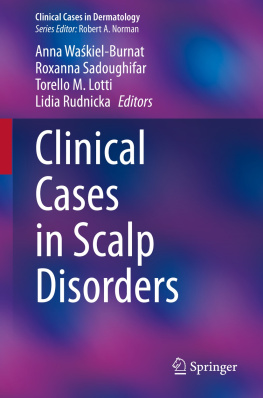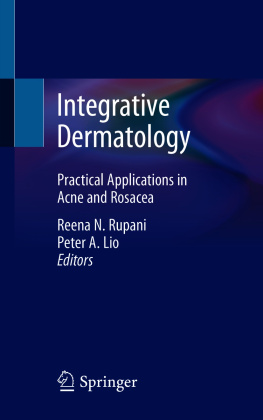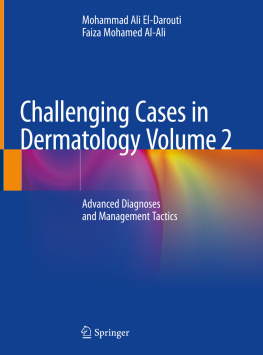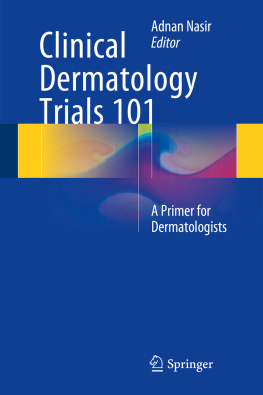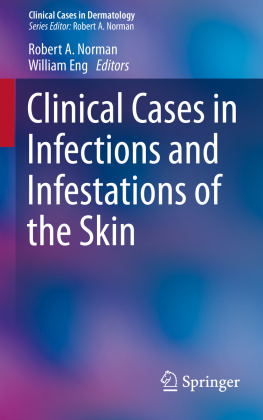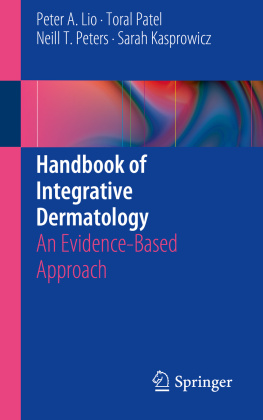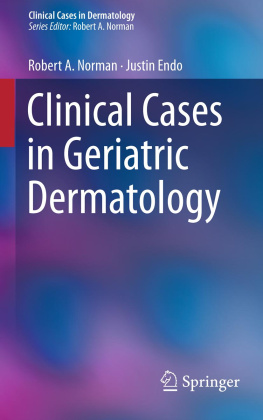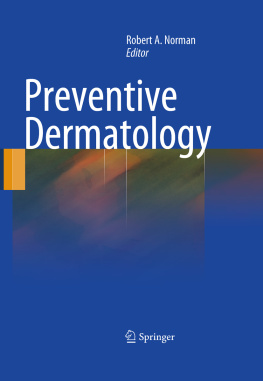Robert A Norman and Reena Rupani - Clinical Cases in Integrative Dermatology
Here you can read online Robert A Norman and Reena Rupani - Clinical Cases in Integrative Dermatology full text of the book (entire story) in english for free. Download pdf and epub, get meaning, cover and reviews about this ebook. year: 2015, publisher: Springer International Publishing, Cham, genre: Romance novel. Description of the work, (preface) as well as reviews are available. Best literature library LitArk.com created for fans of good reading and offers a wide selection of genres:
Romance novel
Science fiction
Adventure
Detective
Science
History
Home and family
Prose
Art
Politics
Computer
Non-fiction
Religion
Business
Children
Humor
Choose a favorite category and find really read worthwhile books. Enjoy immersion in the world of imagination, feel the emotions of the characters or learn something new for yourself, make an fascinating discovery.
- Book:Clinical Cases in Integrative Dermatology
- Author:
- Publisher:Springer International Publishing, Cham
- Genre:
- Year:2015
- Rating:5 / 5
- Favourites:Add to favourites
- Your mark:
- 100
- 1
- 2
- 3
- 4
- 5
Clinical Cases in Integrative Dermatology: summary, description and annotation
We offer to read an annotation, description, summary or preface (depends on what the author of the book "Clinical Cases in Integrative Dermatology" wrote himself). If you haven't found the necessary information about the book — write in the comments, we will try to find it.
Clinical Cases in Integrative Dermatology — read online for free the complete book (whole text) full work
Below is the text of the book, divided by pages. System saving the place of the last page read, allows you to conveniently read the book "Clinical Cases in Integrative Dermatology" online for free, without having to search again every time where you left off. Put a bookmark, and you can go to the page where you finished reading at any time.
Font size:
Interval:
Bookmark:
- Lupus: In systemic lupus, hair loss/thinning is often described by patients. Serum ANA is typically positive, and by review of systems or laboratory analysis, the patient should also meet other criteria for lupus. A scalp biopsy may help confirm the diagnosis if clinically suspicious.
- Trichotillomania: This condition is defined by patients (either consciously or not) pulling out their own hair, often in conjunction with anxiety or depression. In a more subtle version of this condition, patients may pull or twist their hair habitually, gradually leading to loss. Patterns of hair loss are typically more focal.
- Telogen effluvium: The hair growth cycle consists of three phases: anagen (active growth), catagen (transition/resting), and telogen (shedding). Following severe stress, illness, hospitalization, surgery, or pregnancy, patients may notice dramatic shedding of telogen hairs. This typically occurs approximately 3 months after the inciting event. Laboratory workup should be within normal limits, and while this is typically a clinical diagnosis, a scalp biopsy may reveal greater proportions of telogen hairs. A hair pull test should be performed on a day when the patient has not shampooed, and a positive result would be the extraction of 6 or more hairs out of a group of 40 hairs pulled. While typically a self-limiting problem (with resolution of normal hair thickness and growth within 36 months), some cases of telogen effluvium can become chronic and unmask an underlying tendency towards androgenetic alopecia (Fig. ).
 Figure 1.1Diffuse hair loss as can been seen in advanced telogen effluvium
Figure 1.1Diffuse hair loss as can been seen in advanced telogen effluvium - Androgenetic alopecia: Commonly referred to as male pattern baldness, androgenetic alopecia can occur in female patients as well, and can be seen in younger age groups. Male pattern is typically more over the bitemporal region and vertex, whereas female pattern preserves the anterior hairline and begins as widening of the part, progressing to diffuse thinning over the top of the scalp. Thyroid function, iron status, and vitamin D levels should be assessed and optimized. The etiology of androgenetic alopecia is thought to be multifactorial, with components of genetics, hormone levels, and environmental factors playing a role. Onset is usually insidious and progressive.
- Time : The natural course of telogen effluvium is resolution, typically within 36 months, although some cases can become chronic (particularly if the patient has underlying androgenetic alopecia which becomes unmasked). Most often, however, if the inciting factor was an isolated event or occurrence, then full resolution without intervention is typical.
- Counseling : If telogen effluvium is secondary to (or accompanied by) severe stress or anxiety, referral for professional counseling may help break the vicious cycle.
- Minoxidil : Topical minoxidil is available in 2 and 5 % formulations, and while the approved indication is for androgenetic alopecia, may help promote hair growth in telogen effluvium as well (use is off-label). One caution with minoxidil is that, for androgenetic alopecia, cessation of treatment leads to shedding of any regained hairsthis phenomenon, however, is not clear-cut in acute telogen effluvium but remains a possibility of which patients should be aware. Additionally, minoxidil is available in solution and foam formulations, and many patients report irritation with the former (likely from the propylene glycol in the vehicle).
- Avoidance of products containing parabens, sulphates, and phthalates : To generally support healthy hair and discourage breakage of newly growing strands, it is advisable to use hair care products that are as free of potential irritants and carcinogenic or endocrine-disrupting chemicals as possible.
- Eucalyptus oil : The benefits of eucalyptus oil are more in supporting the elasticity and shine of existing hair, rather than promoting new hair growth [], but this effect in turn can improve the patients perception of their hair and reduce the surrounding anxiety of telogen effluvium. Eucalyptus is presently available in commercial root awakening formulas.
- Coconut oil : Contrary to some cultural beliefs, coconut oil does not demonstrate the ability to grow new hair, but rather supports the health of that which is already existing. This oil has the highest ability to penetrate inside the hair shaft based on low molecular weight and linear structure, thus preventing protein loss and improving hair strength and appearance [].
Font size:
Interval:
Bookmark:
Similar books «Clinical Cases in Integrative Dermatology»
Look at similar books to Clinical Cases in Integrative Dermatology. We have selected literature similar in name and meaning in the hope of providing readers with more options to find new, interesting, not yet read works.
Discussion, reviews of the book Clinical Cases in Integrative Dermatology and just readers' own opinions. Leave your comments, write what you think about the work, its meaning or the main characters. Specify what exactly you liked and what you didn't like, and why you think so.


